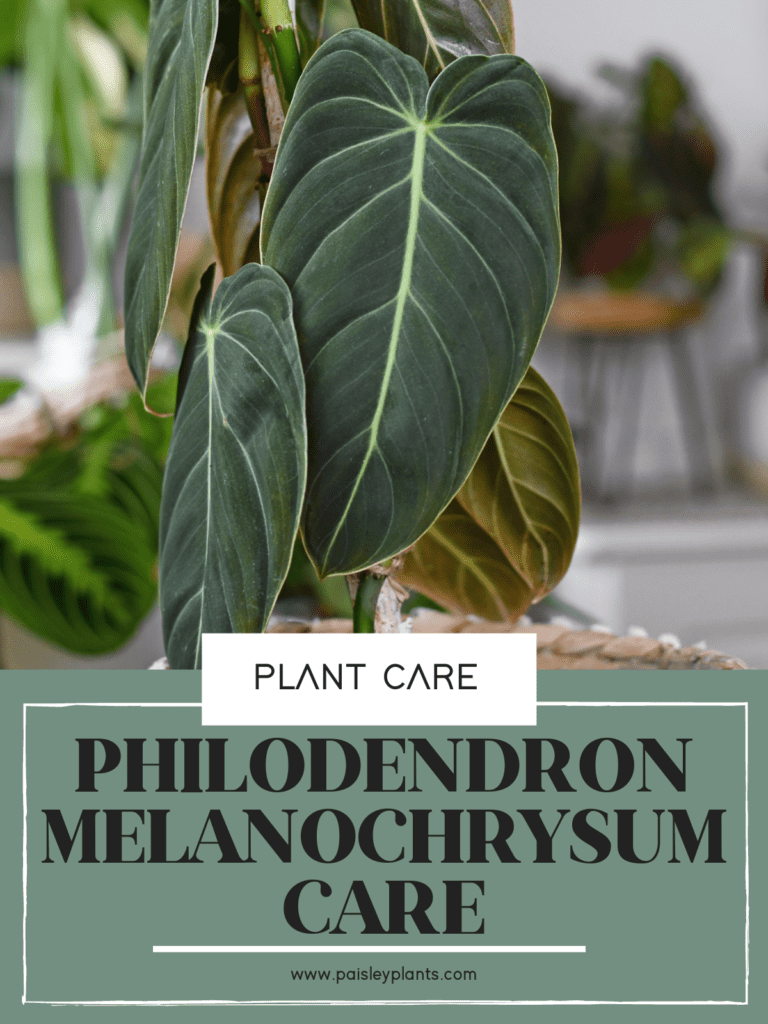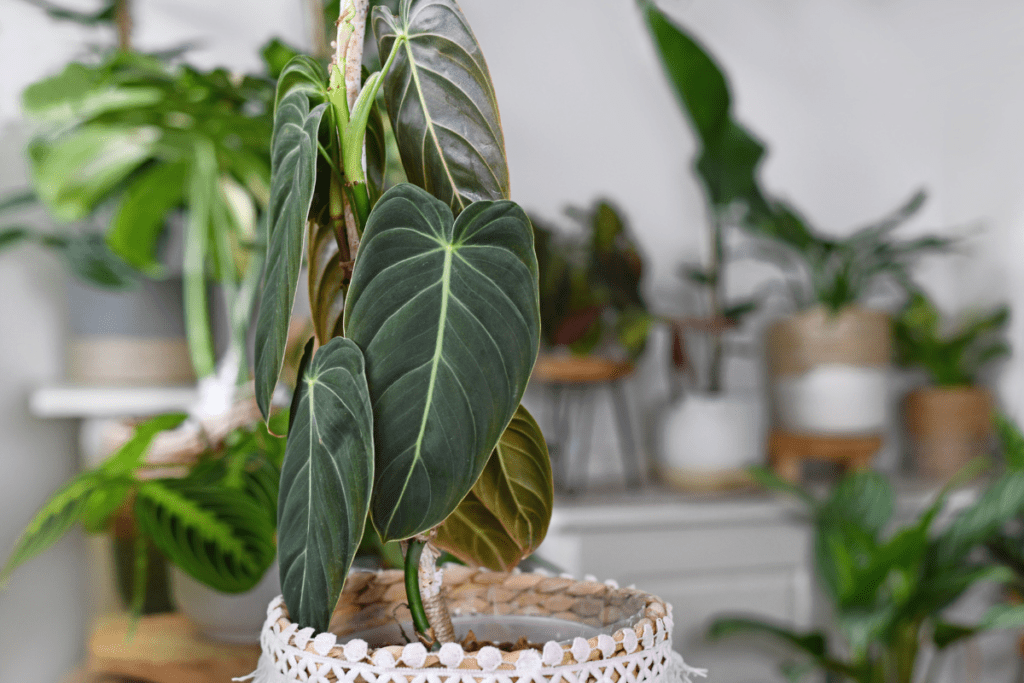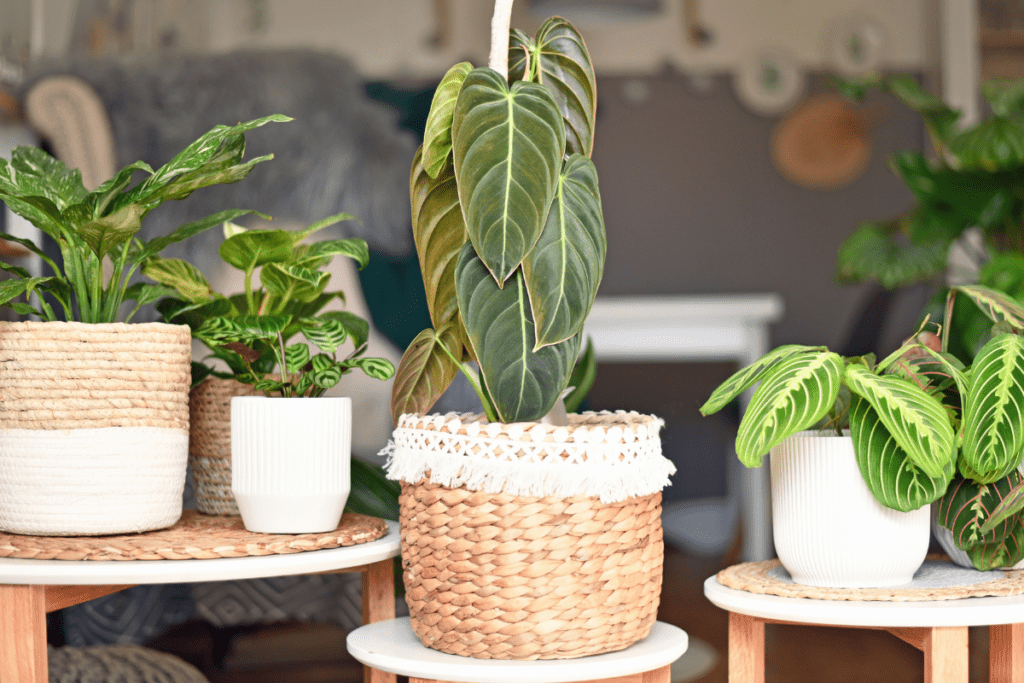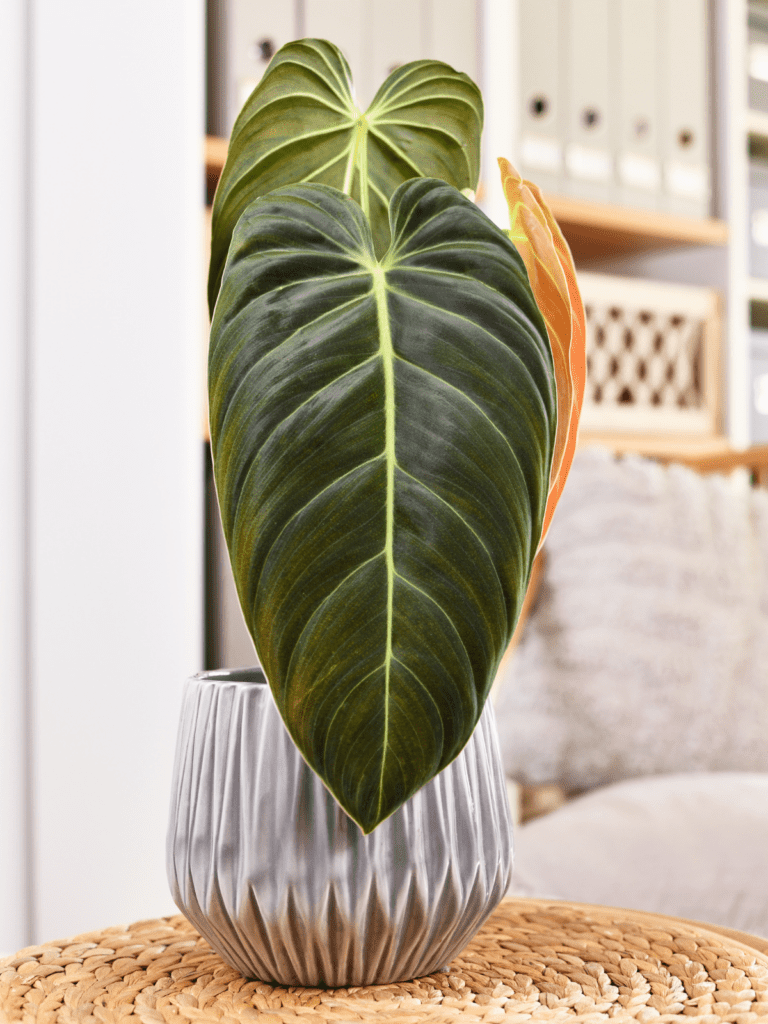If you’re looking for an easy to care for indoor plant that is quite the showstopper, look no further than the Philodendron melanochyrsum! The Philodendron melanochrysum might be rare, but you’ll be pleasantly surprised by how easy it is to care for this plant!
In this article, we’ll be taking a detailed dive into all of the philodendron melanochrysum care tips you need to know. Read on to learn more about these beautiful plants.

This post includes affiliate links.
Table of Contents
Background
Native to the tropical forests of South America, the Philodendron melanochrysum is one of the more rare types of philodendron plant.
The Philodendron melanochrysum is also known by a few common names, including the Philodendron melanochrysum plant and the Black Gold Philodendron.
Philodendron melanochrysum plants are identifiable by their large, velvety green leaves adorned with yellow veins. This is a rather large variety of philodendron, capable of reaching a mature height of 5 feet tall when grown indoors and 12 feet tall when grown outdoors.
The melanochrysum is a climbing variety of philodendron and it is recommended to give these plants a trellis or moss pole to climb upon. I like to use the same moss pole that I use for my monstera plants. They’re easy to grow and the moss poles blend right in with the plants that are using them to climb!
You also may hear about the Philodendron Melanochrysum x Verrucosum. This is just a hybrid plant that has white or bright green veins
Despite their immense beauty, the Philodendron melanochrysum is toxic to both animals and humans. Some people even report developing a rash on their skin when in contact with the plant’s sap.
I recommend exercising extreme caution keeping these plants in the same home as curious pets and children. In addition, any handling of these plants should be done with gloves.
Philodendron melanochrysum Care

Moving on to plant care tips! If you’re looking for tips to grow the rare Philodendron melanochrysum plant as an indoor plant, here’s what you should know!
Sun & Light
Philodendron melanochrysum plants naturally grows under the canopy of the South American forests, and therefore receive dappled light in the wild. You can help replicate these conditions in your home by placing your philodendron in a location that receives bright, yet indirect sunlight.
Please avoid exposing your Philodendron melanochrysum to direct sun rays, as this can cause damage to the leaves. If you don’t have enough nature light, you can use a grow light for your philodendron melanochrysum.
Soil Type
The ideal soil type for a Philodendron melanochrysum is one that is both well-draining, yet can retain moisture. In addition, it should have a high content of organic material and be within the pH range of 5.5 to 6.0 (acidic).
You’ll find that many owners plant their melanochrysum in 100% sphagnum moss. Sphagnum moss is ideal because it is organic and water-retentive, yet still airy. In addition, you may choose to blend your own potting mix of 1:1:1 perlite, peat moss, and orchid bark.
Water

Philodendron melanochrysum plants enjoys a regular water routine and the soil should always be lightly moist. A good rule of thumb as to when your plant needs more water is by monitoring the first few layers of soil; if the top 2-3 inches are dry, then it is appropriate to water your plant.
I like to do the finger test. Stick your finger into the top few inches of soil. If it’s wet and sticks to your finger, don’t water it. If it feels dry and doesn’t stick on your finger, your Philodendron melanochrysum needs some water!
Fertilizer
Fertilizing your plant during its active growing period is one of the foundations to a thriving plant. During the spring & summer, apply a balanced liquid fertilizer to your philodendron.
This should be applied once a month. Completely stop fertilization of your Philodendron melanochrysum during the fall & winter.
Temperature & Humidity
The ideal temperature range for this plant is within 70° to 80° F, which is a typical temperature for most household temperatures. However, don’t let your Philodendron melanochrysum get in an environement that’s below 60° F.
Avoid cold drafts by placing your Philodendron melanochrysum away from areas such as air conditioning vents or drafty windows.
The philodendron is tolerable of normal household humidity levels, though the higher the humidity, the better. You can help increase the humidity level for your Philodendron melanochrysum by introducing an electric humidifier.
Philodendron Pruning & Maintenance
Pruning your philodendron can not only improve the appearance of your plant, but it can also improve the growth pattern of your plant as well. The Philodendron melanochrysum plant does not need regular pruning, but it always a great idea to remove any foliage that appears to be dead or damaged.
Removing these unnecessary parts of these plants will encourage new growth in your philodendron.
Choosing a Container & Repotting a Philodendron
The most important aspect of selecting a container for your philodendron is drainage. Having a pot with ample drainage holes will allow excess water to expel from the plant, which will assist in keeping your plants dry and comfortable.
Your philodendron should be repotted whenever it becomes root bound; this could range between every 1 or 2 years. The most obvious sign of a root bound plant is visible roots peeking out from the drainage holes.
Other signs that you need to repot your Philodendron melanochrysum is that it has stopped growing or the roots are circling around the pot, overlapping one another.
If it’s possible, try to wait until the springtime to repot your Philodendron melanochrysum plant. Select a planter that is slightly larger than the previous one.
How to Propagate a Philodendron melanochrysum
Like with many philodendron plants, you can easily propagate the Philodendron melanochrysum by using a stem cutting. Follow these easy steps to propagate your philodendron and create new plants to gift to your friends and family:
- Take a pair of sharp pruning shears and cut a healthy stem off from your plant. This should have at least two nodes along the stem. A node is a little bump that the roots come from.
- Prune the bottom leaves from the stems; this will expose the nodes. Allow there to be two leaves at the top of the stem cutting.
- Place the cut-end of the cutting in a small jar filled with water, making sure that the remaining leaves are above the rim of the glass to allow for air circulation.
- Place the jar in an area with bright, indirect light. It takes a few weeks for roots to begin to form.
- Allow them to grow until they reach 1 inch in length in order to transfer them into the new pot.
- Fill a pot with well-draining potting mix that has been lightly moistened.
- Transplant the Philodendron Melanochrysum cutting into the pot and keep it consistently moist for the first few weeks. After that, you may allow the soil to partially dry out in between waterings as you would with a mature melanochrysum.
Common Pests in Philodendron Plants
While the Philodendron melanochrysum tends to be relatively pest-resistant, common household pests may still pose a threat to your plants. Examples of these pests include scale, mealybugs, fungus gnats, and spider mites.
Luckily, all of these common pests are highly treatable. One of the most common methods of deterring pests is by spraying your plants with neem oil, which is a completely natural horticultural oil. Fungus gnats can be dealt with by laying down yellow sticky tape around your plants.
Common Diseases in Philodendron
Like with many plants of this kind, it is important to watch out for signs of root rot that might occur in your Philodendron melanochrysum. Root rot is caused by the combination of too-wet soil and not enough drainage.
The excess water gets trapped in the container and causes the roots to break down and rot over time. Common signs of root rot are wilting, yellowing leaves.
Root rot can be very deadly, but when detected early, it is very treatable. Here’s what to do to care for your plant with root rot.
Put on a pair of gardening gloves and remove your Philodendron melanochrysum from its pot. Inspect the roots: they’re rotted if they are mushy in texture and black in color.
Use a sterile pair of pruning shears and cut off any infected ones. Repot your plants in a sterilized planter and pack in fresh, clean soil. For the next few weeks, keep it lightly moist.
The best care prevention for root rot is to always make sure you are allowing the soil to partially dry out in between waterings. In addition, double check to make sure the drainage holes in your Philodendron melanochrysum plant’s pot are unobstructed and can easily allow excess water to pass through.
Common Problems

Yellow Leaves
If your Philodendron melanochrysum is getting yellow leaves the first thing to check is the soil. Yellow leaves likely means that you’ve been over-watering your Philodendron melanochrysum and you need to lay off the water before your plant gets root rot.
You need to address this issue quickly in order to save your plant for possibly getting root rot!
Brown & Crispy Leaves
Philodendron melanochrysum leaves should be a beautiful green color. If they’re starting to look brown and crispy check out the light situation. Is your plant getting direct sunlight? If that’s the case, the direct sun may be burning the leaves.
Try moving your Philodendron melanochrysum into a spot that gets indirect light, not direct light, and see if that stop any more leaves from browning.
Leggy Vines
There’s few things more sad looking than a leggy plant. If your Philodendron melanochrysum is starting to look a bit leggy, there’s a good chance it’s not close enough to a light source and is reaching for the sun.
Try moving your melanochrysum closer to a window to add more light (but not too close) and see if that helps!
FAQ
While it is understandably easy to get both the melanochrysum and micans mixed up, there are a few key differences in leaves that separates the two philodendron plants.
First, the leaves of the melanochrysum are significantly larger than that of the micans; the leaves on Philodendron melanochrysum plants can reach a whopping 24 inches long!
Secondly, the coloring of their leaves are slightly different as well. The leaves of the micans has a reddish-burgundy tone to them, while the melanochrysum has leaves with golden veins.
The best way to get the largest leaves on your Philodendron melanochrysum is to provide it with the best care possible. It is extremely important that you attempt to replicate their natural habitat as closely as possible to make your plants are comfortable enough to grow enormous leaves.
Maintaining warm temperatures & high humidity, regular repotting, and giving it the correct soil are all basic stepping stones you can take towards helping your Philodendron melanochrysum develop big leaves.
This particular variety of philodendron has a moderate growth rate. With proper care, you can anticipate your Philodendron melanochrysum growing around 6 to 12 inches every year.
Where to Buy
There’s many different places to buy the rare Philodendron melanochrysum plant. Here’s a few to check out!
- Local nursery
- Etsy
I hope these melanochrysum plant care tips help you know exactly how to care for your plants! Even though the Philodendron melanochrysum is one of the rarer varieties of philodendron, it’s still a very straightforward plant to care for.
If you’re looking for a tropical plant without the hassle of intensive plant care to grow in your indoor garden, then the Philodendron melanochrysum is the plant for you.
Want more philodendron fun? Check out one of these posts!

